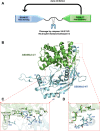Molecular and structural aspects of gasdermin family pores and insights into gasdermin-elicited programmed cell death
- PMID: 34812891
- PMCID: PMC8786298
- DOI: 10.1042/BST20210672
Molecular and structural aspects of gasdermin family pores and insights into gasdermin-elicited programmed cell death
Abstract
Pyroptosis is a highly inflammatory and lytic type of programmed cell death (PCD) commenced by inflammasomes, which sense perturbations in the cytosolic environment. Recently, several ground-breaking studies have linked a family of pore-forming proteins known as gasdermins (GSDMs) to pyroptosis. The human genome encodes six GSDM proteins which have a characteristic feature of forming pores in the plasma membrane resulting in the disruption of cellular homeostasis and subsequent induction of cell death. GSDMs have an N-terminal cytotoxic domain and an auto-inhibitory C-terminal domain linked together through a flexible hinge region whose proteolytic cleavage by various enzymes releases the N-terminal fragment that can insert itself into the inner leaflet of the plasma membrane by binding to acidic lipids leading to pore formation. Emerging studies have disclosed the involvement of GSDMs in various modalities of PCD highlighting their role in diverse cellular and pathological processes. Recently, the cryo-EM structures of the GSDMA3 and GSDMD pores were resolved which have provided valuable insights into the pore formation process of GSDMs. Here, we discuss the current knowledge regarding the role of GSDMs in PCD, structural and molecular aspects of autoinhibition, and pore formation mechanism followed by a summary of functional consequences of gasdermin-induced membrane permeabilization.
Keywords: gasdermin; inflammasome; pore-forming proteins; programmed cell death; pyroptosis.
© 2021 The Author(s).
Conflict of interest statement
The authors declare that there are no competing interests associated with the manuscript.
Figures



References
Publication types
MeSH terms
Substances
LinkOut - more resources
Full Text Sources

